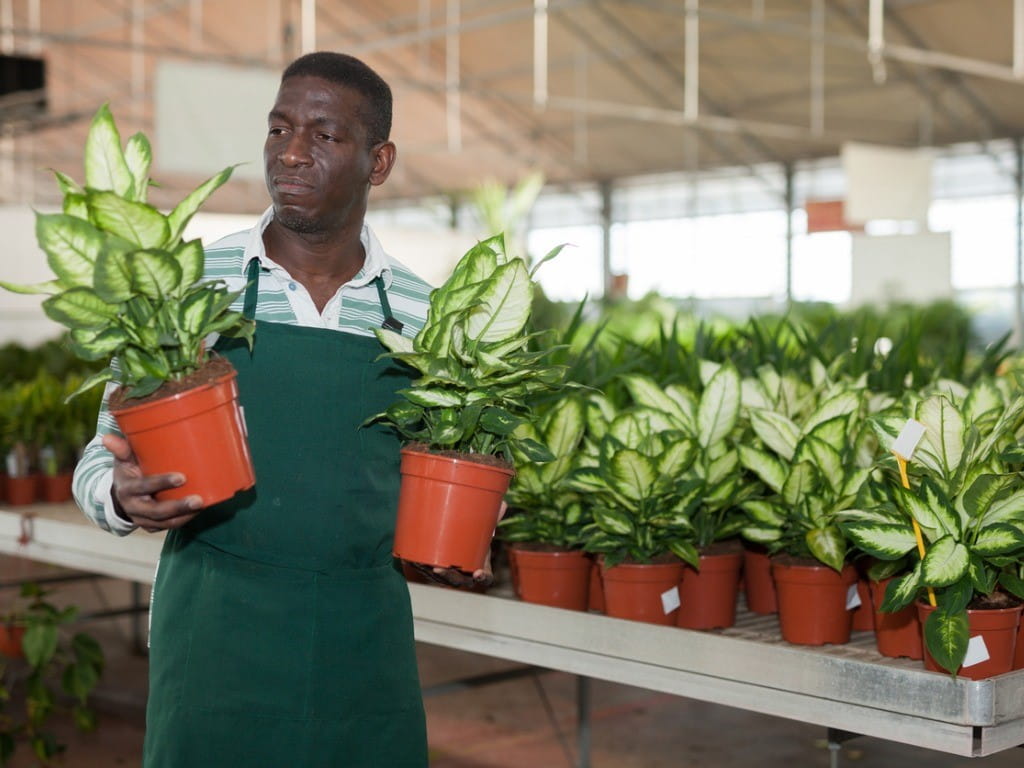Dieffenbachia and Philodendron Two Popular but Poisonous Houseplants

The Bottom Line
Both Dieffenbachia and Philodendron are great houseplants for beginners. However, both plants contain oxalates which can cause swelling, drooling, and loss of speech if swallowed. Swelling, redness, and irritation can also occur if the skin or eyes are exposed. Dieffenbachia and Philodendron plants should be handled carefully and kept away from children and pets.

The Full Story
Both Dieffenbachia and Philodendron are easy to grow houseplants, making them popular with novice as well as experienced plant lovers. Together, these genuses of flowering plants include over 500 species. Although Dieffenbachia and Philodendron are different plants, they both cause toxicity in similar ways.
Dieffenbachia plants are known by several common names, such as "dumb cane" and "mother-in-law's tongue," which describe their toxicity when this plant is ingested. Dracaena is an unrelated genus of plants that also goes by the common name "mother-in-law's tongue." Depending on the species of Dieffenbachia, the thick, broad leaves are usually a combination of green, white, and yellow. Some can grow as tall as 6 to 8 feet while others can be kept pruned to remain as short as 12 inches. Dieffenbachia produce flowers seasonally but rarely flower when kept as indoor plants. These plants can also produce sap that can cause painful irritation when touched.
Philodendron plants usually have large leaves that are lobed or deeply cut. The leaves can be oval or spear shaped, but they can be various other shapes. Some species are vining plants with aerial roots and can climb to great heights.
Both Dieffenbachia and Philodendron contain calcium oxalate, which can cause toxicity when the plant is handled improperly or eaten. These oxalates form "raphides," which are tiny, needle-like structures. The role of calcium oxalate crystals in these plants is not entirely understood; perhaps they are a protective feature to discourage herbivores. Raphides can cause mechanical injury and painful microtrauma leading to immediate pain and swelling when the plant is chewed or when the sap gets on skin or eyes.
All parts of the Dieffenbachia plant contain raphides. The raphides in Dieffenbachia plants also release proteolytic enzymes which increase the severity of symptoms, causing swelling and respiratory distress. Oxalates are typically found in the leaves of Philodendron plants. Some Philodendron species can produce edible fruit. However, unripe fruit will contain calcium oxalates.
In severe oral exposures, the pain and swelling can lead to excessive drooling, difficult or painful swallowing, and loss of speech. Skin exposure can lead to rash, swelling, redness, and dermatitis (skin inflammation). Touching the sap and then touching your eye can lead to eye irritation, corneal abrasions, and, rarely, permanent eye damage.
For ingestions, rinse with water and spit to remove any remaining plant materials from the mouth. If the mouth continues to be irritated, sucking on ice chips or frozen treats can relieve pain. Do not force fluids. If the person is drooling excessively, has severe mouth swelling, or is having difficulty swallowing or breathing, call 911. If you come into contact with the sap, you should immediately wash the affected area thoroughly with soap and water for 15 minutes. If the sap comes into contact with your eyes, immediately irrigate with water for at least 15 minutes. Seek medical attention if symptoms are severe or do not improve.
If you are worried about an exposure to either Dieffenbachia or Philodendron plants, check the webPOISONCONTROL® online tool for guidance or call Poison Control at 1-800-222-1222. Whether you log on or call, expert assistance is available 24 hours a day.
Diana N. Pei, PharmD
Certified Specialist in Poison Information
Poisoned?
Call 1-800-222-1222 or
Prevention Tips
- Have all your plants (indoor and outdoor) correctly identified by a knowledgeable expert.
- Keep all plants out of reach of children and pets.
This Really Happened
Case 1. A 66-year-old woman was moving her Dieffenbachia plant when a stem broke off and the sap leaked onto her hands. It caused immediate burning and irritation. She washed her hands for about a minute and applied Neosporin. Poison Control instructed her to wash her hands with soap and water for 15 minutes. When Poison Control called back 30 minutes after the initial call, the burning sensation had completely resolved.
Case 2. An 18-month-old boy chewed on a Dieffenbachia leaf. Immediately afterward, he started gagging and sticking his hands into his mouth. He did not vomit, nor was he in any distress. Poison Control instructed his mother to rinse out his mouth well and to offer him something cold and creamy to eat or drink. When Poison Control called back in an hour, all of his symptoms had subsided and he had returned to normal.
Case 3. A 55-year-old woman unintentionally tasted a Philodendron, she had mistaken it for a piece of kale. Immediately afterward, she developed irritation in her mouth. Poison Control recommended a soothing snack like ice cream or yogurt to help with her symptoms. When Poison Control called back the next day, all of her symptoms had resolved.
For More Information
References
Dieffenbachia. Gainesville (FL): University of Florida [cited 2020 Jun 1].
Miller R. Is oozing Dieffenbachia harmful? San Francisco: SFGate [cited 2020 Jun 1].
Philodendron plant overview. New York: Provide Commerce [cited 2020 Jun 2].
Poisoned?
Call 1-800-222-1222 or
Prevention Tips
- Have all your plants (indoor and outdoor) correctly identified by a knowledgeable expert.
- Keep all plants out of reach of children and pets.
This Really Happened
Case 1. A 66-year-old woman was moving her Dieffenbachia plant when a stem broke off and the sap leaked onto her hands. It caused immediate burning and irritation. She washed her hands for about a minute and applied Neosporin. Poison Control instructed her to wash her hands with soap and water for 15 minutes. When Poison Control called back 30 minutes after the initial call, the burning sensation had completely resolved.
Case 2. An 18-month-old boy chewed on a Dieffenbachia leaf. Immediately afterward, he started gagging and sticking his hands into his mouth. He did not vomit, nor was he in any distress. Poison Control instructed his mother to rinse out his mouth well and to offer him something cold and creamy to eat or drink. When Poison Control called back in an hour, all of his symptoms had subsided and he had returned to normal.
Case 3. A 55-year-old woman unintentionally tasted a Philodendron, she had mistaken it for a piece of kale. Immediately afterward, she developed irritation in her mouth. Poison Control recommended a soothing snack like ice cream or yogurt to help with her symptoms. When Poison Control called back the next day, all of her symptoms had resolved.
